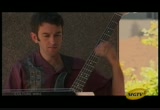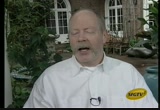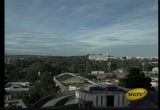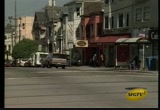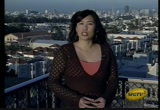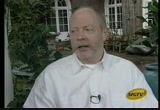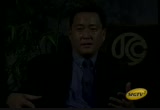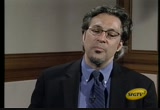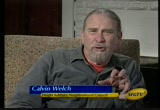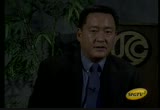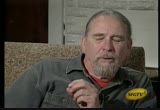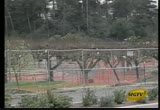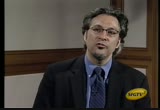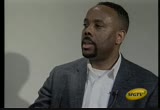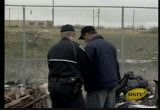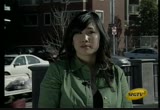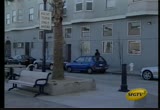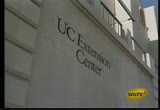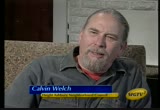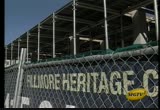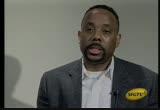tv [untitled] September 19, 2010 9:00am-9:30am PST
10:00 am
what began as a forum for performers who were paid by passing the hat has become a program that provides wide exposure and more than 500 paid gigs annually for local musicians. from july through september, people in plazas produces almost 300 free performances in the lunchtime hour. the mission of people in plazas generates social congregation. and by having these events, we encourage people to make these plazas everybody's neighborhood. >> recently, the san francisco arts commission was awarded a $ 250,000 grant for the national endowment for the arts. to establish an arts district in the central market corridor between fifth and 10th street. throughout the yearing the arts commission will partner with people in plazas to activate the
10:01 am
sidewalks along this stretch with art installation, opening events, live music, and new arts and antique markets at u.n. plaza. >> this area has been sleighted for many years, at least the past 25 years. i think that this redevelopment project and the n.e.a. grant are very positive signs that we have political will and a lot of momentum to really make the mid market area what it could be, which is a vibrant area where everybody is welcome and it's a place to be in san francisco. >> to get a feel for the future of the central market arts and culture district, be sure to catch out an upcoming concert. for locations and times, visit peopleinplazas.org. to learn more about the central market revitalization initiative, visit sfartcommission.org. thank you for watching "culture wire."
10:02 am
>> my relationship with district five is a love affair. district five is very much a microcosm i think of san francisco altogether. what makes it fantastic is its diversity. it's really a unique district. it extends westward from geoff street, encompassing hayes valley, western addition, lower haight, upper haight, cole valley, inner sunset to ninth and lincoln and bows over to north of panhandle, japantown and lower pac heights. >> what's unique about any community, especially the western addition, is that throughout the way it's publicized about the shootings,
10:03 am
murders, crime, everybody run around particularly scared, that children come here with smiles on their faces. just a community, a vibrant community, despite what people are saying. >> hayes valley is unique in that there is so much here, ranging from the zen center, where we're sitting today, to the lgbt center, african-american arts and cultural center, korean american center of some of the non-profits and all of the shops and restaurants along haight street and hayes street being within walking distance of city hall and the symphony, ballet, the open practice, the neighborhood offers something to everybody. this is the oldest and first japantown established in the united states of america. it's where the japanese first landed to begin diplomatic relationships, in the mid-and late 1900's, was the first place where the consulate was
10:04 am
established. the first buddhist church, the first christian church, the first non-profit, the first businesses were created here. so it has a unique place in not only japanese-american history but california history for the japanese to begin to develop community here in america. it is still a gathering place not only for the japanese-americans in san francisco but throughout the bay area. >> tkpwo*ep golden gate park park is beautiful. the physical beauty is hard to beat. it is well served by public transit. its central location is extraordinary. without question, haight ashbury is one of the most famous neighborhood in the world. there is a certain live and let live tradition. it's actually a surprisingly small town feeling. >> if you choose to buy a house in the haight ashbury, you're choosing to buy into a folklore,
10:05 am
to a sense of community, to the high hippy culture, and all of that sensibility. and so it may attract five drug dealers from des moines, it also attracts seven lawyers from new york, trying to live some sort of mythical hippy what goes around comes around lifestyle. >> both western addition, fillmore and japantown are amazing neighborhoods. one devs as much enrichment as we can. hayes valley is being reborn as an adjunct of the western addition with the dismantling of the central freeway after loma prieta-aened the reinvestment within hayes valley is now becoming this kind of chic area which i hope disp not lose its populism. lower haight is a wonderful help place, but it has suffered
10:06 am
because of crime, i believe, and some of the economic downturn that we have noticed post dotcom implosion. upper haight has always been just a mecca. it deserves collective attention in making sure haight ashbury is not compromised but also an area we want to make sure is accessible for all. cole valley neighborhood, you know, to haight, is a bit of a hamlet, an enclave near the haight, in between there and ucsf and inner sunset. inner sunset, it's just a great swing area. what i mean by that is you just have such a great combination between merchants and residents, mass transit hub, a lower pac heights, certainly wants to enjoy the prosperity of pac heights but not want to lose its diversity that spills over from the fillmore western addition area. north of pan handle is a
10:07 am
composite of everything i have just said. those are the aspects of the district, neighborhood by neighborhood, that makes it a challenging and needy district, but one i love and am responding to. >> ♪ >> welcome to another addition of district sf, sftv's profile of san francisco neighborhoods an their issues. i'm jennifer lowe. today we will focus on district five. let's get started by looking at the problems the residents are facing. >> any of the problems we speak of in district five i think we're speaking of about the city overall. when i -- i shall share with you whether it's a question of housing, affordable housing, public safety, making sure that
10:08 am
violent crime and homicides that have plagued san francisco for two years, unprecedented which we haven't seen in 12 years, i believe, the kind of people displacement of, as i said working class and african-americans, speaks to a trend that i think, overall, we should be concerned about in san francisco, so that this city, 10 years, 20 years from now, is not one that is delineated into two san franciscos, where the have and have notes. >> we are still in the midst of having to fight every single day for our portion of jobs, for the city, for our portions of appropriate housing for our community, and our share of whatever activities that can move a community forward. so that's like a constant fight. if you go out to for instance pacific heights, if you go to forest hill, we want the same thing we want. safe clean neighborhoods, we want to walk down the street, go
10:09 am
to a store and get wit what we . we want police that walk down the street and not terrorize but humanize people. the biggest problems is how to achieve the balance, how to keep the diversity, how do we keep a vibrant neighborhood with so many people involved. real estate developers are targeting the area for people just to come and be freeway close to silicon valley where they might work. we're concerned about what balance that takes away from the neighborhood if you have people that don't feel a part of it because they're just commuting. >> we have families here who may be in difficult social economic terms, and what can we give to them, how do we achieve balance between those families and people who can drop 100 for dinner. >> the japanese-american community here is small relative to other cities throughout the bay area. a lot of challenges we're facing
10:10 am
is demographics, sustainibility. a lot of ways, san francisco has just become really family unfriendly. i see it here in this community. i don't see kids running up and down the streets, playing or going to and from places anymore. i see playgrounds empty, schools closing. something's wrong here. you know, because families are our big part of making up a neighborhood. and i just don't -- i don't see them here in this community. >> in many parts of san francisco, a delicate balance must be maintained to meet the needs of visitors, shoppers and local residents. let's see how district five manages this balancing act. >> i think we do a fairly good job, a good job of balancing the needs of the residents with those of tourists in district five because district five is a high tourist destination. in essence we're kind of host to the crown jewels of san francisco. we have all these great merchant areas attached to these
10:11 am
wonderful neighborhoods that attract tourists who come from all over the world. the very notion that we are tourist-rich in our district is the very notion that adds to the reason why i yell and scream for services from the rec and park department, make sure our parks, our gardeners are there, doing what they're supposed to do, making sure the police are accessible and that they're seen and not just being a deterrence but the kind of peace brokers, where they are engaging people, making people feel good about being there while sending a signal that crime is not welcome. where to our sanitation, our public works department, to make g sure that whether it's a resident or tourist car will not fall into a pothole and we have to tow it out. those are lets of what makes our district a happy district to those who live there and visit there. >> ever since the summer of love
10:12 am
it has a reputation that has attracted visits and new residents from all over. >> the hate ashbury -- haight ashbury, the movement, will always have that bit of a reputation. in one way you want to try to protect and retain that reputation without looking like you're selling out. at the same time, you know, you want to make it where it's hospitable where it is accessible, where it welcomes everybody. and you want to make it so that it's not just for, you know, those who are hanging out in the street, panhandling for change, or those who are trying to, you know, seek a new mecca destination, but people who live there and want to shop there feel that this is their community too. i think some good legislation has been put in place where there is a formula retail conditional use in that particular area, so that chain stores will have a high bar in
10:13 am
order to get in, in that area. we try to make it mom and pop driven sensitive. we want to see -- i'd like to see certainly more, you know, just kind of independent businesses going in in that area. >> it is a residential street. it is in the midst of a residential neighborhood. and i think there is a general and overwhelming consensus that the commercial activities on haight street should be small, contained, and as here as possible as is economically possible, which is not very economically possible as neighborhood serving as possible. unfortunately, the market forces in this part of the world are immensely strong. and what we're seeing is more and more speciality retail on haight street. >> hayes valley is certainly impacted by its proximity to both our seat of government and our performing arts institutions.
10:14 am
we're very fortunate to be located right on the boundary of both of those wonderful resources. and certainly do have some problems when people are coming to, for instance, the symphony and the opera on the same night. people who drive into the area, they want to have dinner first, they want to park they want to go. there are not enough parking spaces. there are not enough seats in the restaurants for people to be able to just come in, drop in, and have a pleasant evening without having a big impact on the neighborhood itself. >> in japantown the balance between tourism, the community itself and the residents has always been a unique balance. i think it's been a good balance but not one that's always been done in full cooperation of each other. certainly we've had our influences by government that has dictated changes, evicted residents, evicted businesses, allowed other businesses to come in, not necessarily with
10:15 am
community support or input. redevelopment was really to create -- what in my opinion as much to eliminate blight but to create a tourist destination. san francisco japantown is really in the heart of san francisco. there are not that many japanese-americans that live in japantown anymore because they were all evicted during the 60's and 70's and a lot were unable to come back. the 1100 or so are seniors, living in senior housing. >> in upper haight activities in golden gate park and the medical center have a big impact on the quality of life. let's see how the entities affect the haight and how haight residents affect the park and uc. >> haight ashbury neighborhood council is proud of the fact that the university of california san francisco parnassus campus is the only uc campus that was forced to impose upon itself and has maintained a growth limit, which is one of the reasons that we're very happy that they're moving to
10:16 am
mission bay and that's where their continued growth will go. that's one of the real struggles, on going struggles in this neighborhood is dealing with ucsf, st. mary's, and other institutions. the previous three administrations have taken the position that recreation and parks department should be a revenue department, that it should basically produce enough revenue to pay for the maintenance of the park. the problem is, of course, that it doesn't. and that there is a fundamental and basic contradiction between maintenance of the parks, and recreational facilities, and maximizing revenue from the use of the parks and recreational facilities. it is a struggle that the haight ashbury neighborhood council is very much involved in. perhaps the biggest challenge
10:17 am
has been in the eastern portion of the park, and in the eastern portion of the park, the current rebuilding of the aquarium and of course the near completed development of the deyoung museum and the concurrent development of a large underground parking facility. that has raised very serious questions. we have been very much involved in trying to deal with the policy complications of those questions. but -- implications of those questions but it is an ongoing struggle. the park place an extraordinarily important role in traffic circulation and population, when it is ala cart in the park, when it is opera in the park, blues festival in the park, it is all of those things to this neighborhood as well. >> in 2005 san francisco's murder rate was higher than in years. we asked our guests why they thought violence was increasing and what quee can do about it. >> every person who lost their life in this strict, it's almost
10:18 am
like it sends out this shock wave and nobody is concerned about where the shock wave ends. they will come out and say well we set up this, we set up that, we set up this. but you set it up. we already know the distrust from the people in the community. so automatically everybody in this community know that whatever they set up is not working. >> what i have been working on hard since coming into office last year is reforming how community policing is conducted. there really is no method, and no law or code in the books of san francisco's administrative codes or city services code, nor within the general orders of the police department itself. >> the police are primarily responsible to solve a lot of crime in the community. so there is a large segment of the community that don't place the -- truss did -- trust the police. it won't be solved by ignoring
10:19 am
the power of the people here in the community. because they deserve a better service from the police department. >> we're seeing a high spike of truancy. we're seeing young ones watch their older peers, still under 21 years of age, commit crimes. that compounded by reduction of recreation and park services to dissuade kids from the streets in a positive way, or shut down of good public schools, or the lack of summer school, or the lack of just jobs for our young people or people coming out of the prison system, returning back to the western addition or parts of district five. i want to see san francisco commit to a multi-agency sort of process, where its police department, unified school district, department of public health, adult juvenile probation, all these variables of agencies that have services in mind, and yet by practice,
10:20 am
they don't even talk to each other. i've been seeking everything from simplistically getting more beat controls on the streets of san francisco so that can enhance the trust between police and residents and merchants itself. >> violence sometimes is allowed to happen too often. you know, i believe that for instance this -- street, we know that there are always problems on that block. the only time the police come is when they're in hot pursuit. they don't ever walk down and talk with the kids or maybe even sit up there. >> i'd like to see police, as well as other city service agencies held objectable, --bilitiable helping us to enhance our local hiring commitments for people in more impoverished communities, making sure that children who may not have a school to go to or after school program they would like to go to, where there was one, that we could compensate so
10:21 am
there is something positive for them it enjoy. where parenting skills sometimes need a lot of attention because it's not the city or police but the parents need to be better at parenting. we need programs that are designed for that particular community or population. >> we weren't against law enforcement. what we were against was law enforcement oppressing those before they even committed a crime. that's what we're against. it is a foundation of a lot of the problems with the police department right now. how can people respect the law if they can't respect the people in the community. the. >> the octavia boulevard is the first urban boulevard to be built in the united states in 50 years, and is an exceptional piece of work. now that the boulevard is in we find we still have traffic issues, but things are certainly better than they were when the freeway was in place. and the hayes valley area remains more vibrant.
10:22 am
people walking along the boulevard. it's absolutely wonderful to go to the hayes green because any day where the weather is halfway decent there are not only people sitting around and doing what have you, but there are children there. >> san francisco always seems to be sfaised with a challenge of providing more housing. as with any other neighborhood, district five has to provide housing as well, while preserving historic buildings, diversity and the neighborhood character. >> what i think about gentrification? i think that it's all connected to opportunities. and i think that the shame it's not really about gentrification. the problem is that many minority people were never allowed to build the wealth and build and have the opportunities to be able to access the same properties and the same rents as other people. the way we see it at l.a. hill
10:23 am
heights, if we take these young people right now and insure their success through the school system, and -- there's another chapter on the school system right now and we're going to that. but we can insure their success through the school system or to college or whatever, to insure that they have appropriate income, to be able to afford to live in this city. we won't have an issue with gentrification. as far as the housing already goes is that i know a lot of times they took all the housing that was built back in the 40's and 50's or even 60's and demolished it thinking that demolishing builds housing projects somehow would reviolatesize the community and they -- revitalize the community. but they tore down 500 and built 100. >> the area has gentrified a great deal, particularly since the freeway came down. there is a balance because there's a lot of rental stock in the neighborhood. but there's also a concern, as
10:24 am
in many neighborhoods, that, as hayes valley becomes even more desirable, more people will want to come in and will that displace people that have been here for a while, particularly in the african-american population that feels itself being pushed out of hayes valley, the western addition of san francisco. >> the impact of housing surrounding the boulevard and the neighborhood was one that was taken into account when the freeway wars were joined. one thing that the neighborhood association was able to write into the legislation was that, when the freeway was torn down, the part that wasn't replaced by octavia boulevard, has to, by law, being converted into housing. and half of that housing, also by law, again written with the help of people from hayes valley neighborhood, has to be affordable housing. hayes valley can continue to improve with more deposits housing along the boulevard --
10:25 am
dense housing along the boulevard parcels because the density itself allows for neighborhood-serving retail on the ground level of all of those doalts. >> historic preservation is key to people within hayes valley. because so many of the houses here were built in the late 19th century, because there were redevelopment issues through the 60's all the way through the 90's. some housing was torn down and rebuilt. one of the key situations in hayes valley, as we are taping this is what's going to happen with the uc site which is two square blocks, sick acres of publicly owned site in the middle of san francisco. there's concern whether there will be enough private and publicly zoned space available to provide resources for all the new people coming into the neighborhood. >> i think land being used for solely market rate housing in this neighborhood, i think more
10:26 am
affordable housing and housing for families that are affordable are definitely needed. we've kind of become a place where a lot of senior housing is being developed, which is a good thing. but i don't want -- there needs to be a balance. >> imagine our surprise when mayor newsom decides that maybe the problem, the solution to the problem of homelessness is housing first. some of us have been articulating that for some time. and i think this neighborhood has led, not in nimby battles against the housing -- affordable housing, but has led in the battle to build affordable housing on either surplus school sites or old disused sites. >> mainly one of the biggest issues in district five has been school closures. supervisor mirkarimi and residents have been outspoken of their criticism of the process. >> the school closure process i
10:27 am
think was a travesty. it was last year, and then just very recently again, early 2006, another six were slated for closure, merger and/or relocation. that would have almost completely uprooted just about every school in our district, due to inclining enrollment. understandably there's budget shortfalls that require the board of education, in order to reconcile that dollar deficit. but what i am alarmed about is the disproportionate impact of school closures and mergers in communities of clr, particularly african-american, latino and working class communities. the kind of rye form i want to see happen is not only do we want to have a five year plan that speak to how are we going to shut down our merged schools but what can we do to reverse the trend of declining enrollment. what about planning and land use data which is not currently considered in the school closure
10:28 am
process. >> to close out, we asked participate pants to ask us about some of the positive developments that are happening in their community. >> some of the greatest developments happening within district five is representative of the tapestry of our district because it is such an eclectic district, whether it is the development that is coming because of the dismantling of the freeway, how hayes valley is booming or in the lower fillmore because of the development in the lower fillmore and revitalizing the jazz corridor down there or seeing the diverse der in terms of its prosperity and inner sunset and upper ha*euts benefit from the changes in golden gate park. >> there are so many positive things that happened in hayes valley. the octavia boulevard and the vibrancy that's brought along with the hayes green at the end of the boulevard, the decrease in many of our crime issues, and one of the things that we're
10:29 am
looking toward in the hayes valley area is more publicly funded and privately funded temporary art. one of the most positive aspects of hayes valley i would say it's the people and the way the people work together. >> there are so many people in the community right now like kind of focus on trying to like help young people and help families. we got this one program called young academic achievers. this program works with kids that are doing well in school to make sure they keep doing well. they're being influenced by kids that are having problems in school. we have another program called comprehensive program in schools, and offering support services and life skills. >> one of the greatest opportunities coming up is the 100th anniversary of japantown and hoping to better recognize its importance to california san francisco history as well as what japantown a
64 Views
IN COLLECTIONS
SFGTV2: San Francisco Government Television Television Archive
Television Archive  Television Archive News Search Service
Television Archive News Search Service 
Uploaded by TV Archive on

 Live Music Archive
Live Music Archive Librivox Free Audio
Librivox Free Audio Metropolitan Museum
Metropolitan Museum Cleveland Museum of Art
Cleveland Museum of Art Internet Arcade
Internet Arcade Console Living Room
Console Living Room Books to Borrow
Books to Borrow Open Library
Open Library TV News
TV News Understanding 9/11
Understanding 9/11